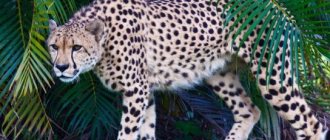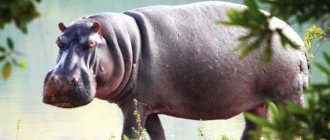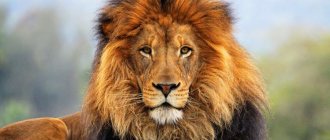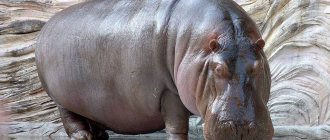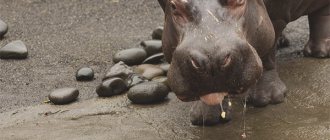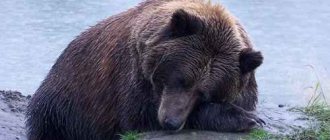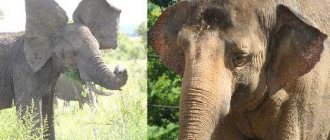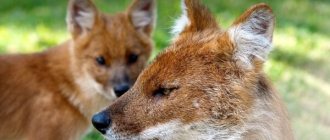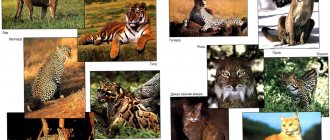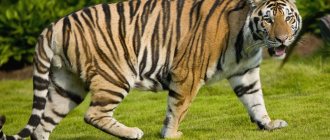07 July 65302 herbivores or herbivores artiodactyls giraffe large
The giraffe is a mammal from the order Artiodactyls. The giraffe is the tallest animal on the planet. The giraffe is an intelligent and peace-loving animal that has been familiar to us since childhood. In this article you will find a photo and description of a giraffe, and also learn a lot of interesting things about this unique and wonderful animal.
Description
The giraffe is the tallest land mammal on the planet. Males reach a height of 5.7 meters from the ground to the horns: 3.3 meters to the shoulders and the neck rises 2.4 meters. Females are 0.7-1 meter shorter than males. The weight of a male is about 1930 kg, and that of a female is 1180 kg. The cub is born with a weight of 50 – 55 kg and a height of about 2 meters.
Giraffes of both sexes are spotted. It varies depending on the habitat. All nine subspecies have different patterns. The spots characteristic of giraffes can be small, medium or large in size. The color of the spots varies from yellow to black. Throughout the life of a giraffe, the pattern remains unchanged. But depending on the season and the health of the animal, the color of the coat may change.
The giraffe has long and strong legs. In this case, the front legs are longer than the hind legs. The neck consists of seven elongated vertebrae. Giraffes have a sloping back, a thin and long tail, about 76-101 cm. The black tassel at the end of the tail is used by the animal to get rid of annoying flies and other flying insects. A giraffe's horns are bony projections covered with skin and hair. The horns of females are thin and have tassels. In males they are thick and the fur is smooth. There is often a bone growth on the forehead, which is mistaken for the middle horn. Their eyes are large, and their tongue is black and long, about 45 cm, for better capture of food from the very tops of trees.
Fights.
Giraffes are extremely peaceful and even timid animals, but males fight among themselves for leadership, and animals of both sexes engage in fights with predators if they cannot escape from them.
Within each population, the relationships of adult males are hierarchical. Hierarchy is maintained through fighting or threatening postures, such as lowering the neck to an almost horizontal position, as if the animal is preparing to butt an opponent. When fighting, two or more males stand side by side, facing the same or opposite directions, and swing their necks like giant hammers, trying to hit each other. The fight is often ritualized and does not cause harm to the participants, but sometimes, especially if several males are competing for a female ready to mate, it can end in a real knockout.
In a fight with a predator, the giraffe either slashes downwards with its front legs or kicks with its hind legs. The giraffe's hooves are very large - the diameter of the front ones reaches 23 cm. It is known that giraffes even killed attacking lions with a blow of their hooves.
Habitat
Giraffes live in the arid regions of Africa. They prefer areas with a lot of acacia growing. They can be found in savannas, woodlands and meadows. Because giraffes drink only occasionally, they live in dry lands far from water sources. Males tend to venture into more wooded areas in search of foliage.
Giraffes are not territorial animals. Their habitat range varies from 5 to 654 square kilometers, depending on the availability of water and food sources.
Where do they live?
The habitat of modern giraffes is limited to the African continent. Judging by excavation data, about 5-7 thousand years ago, representatives of the family lived in northern Africa. Currently, these animals can be found in the east of the continent, where the most numerous populations live, and in some regions located south of the Sahara.
Where live
Reticulate
The giraffe's natural habitat is flat areas: savannas, dry and variable wet forests. At the same time, animals prefer open forests with a small number of trees. Giraffes are not found in dense equatorial forests, desert regions, and also avoid wetlands.
Reproduction
Giraffes are polygamous animals. Males carefully guard their females from other males. Courtship begins when the male approaches the female and analyzes her urine. The male then rubs his head next to the sacrum of his chosen one and places his head on her back to rest. He licks the female's tail and raises his front paw. If the female has accepted the courtship, she goes around the male and holds her tail for the mating position, after which the process of copulation itself occurs.
Conception occurs during the rainy season, and the birth of cubs occurs during the dry months. Most births take place between May and August. Females breed every 20-30 months. The duration of pregnancy is about 457 days. Females give birth standing or while walking. The cub is born with a height of about 2 meters. Most often, one calf is born; Twins do occur, but very rarely. Newborns stand on their feet and begin to suckle fifteen minutes after birth. The cubs hide for most of the day and night during the first week of their lives. The period of stay of a female cub next to its mother lasts 12-16 months, and a male cub – 12-14 months. The period of independence varies depending on gender. Females tend to stay in the herd. However, males remain solitary until they develop their own herd, where they can become dominant males. Females reach sexual maturity at the age of 3-4 years, but do not breed for at least one year. At the age of 4-5 years, males become sexually mature. However, they do not reproduce until they reach the age of seven.
3-4 weeks after birth, females send their offspring to nurseries. This allows mothers to separate from their cubs over long distances to obtain food and drink. Mother giraffes take turns watching the young in a group. Thanks to such groups, females have the opportunity to move away to distances of about 200 meters. But before darkness falls, they return to the calves to feed them milk and protect them from nocturnal predators.
Lifestyle
Giraffes are social animals that live in free, open herds. The number of individuals is from 10 to 20, although cases of 70 individuals in one herd have been recorded. Individuals can join or leave the herd at will. Herds consist of females, males and cubs of different sexes and ages. Females are more socialized than males.
Giraffes consume food and water in the morning and evening. These mammals rest at night in a standing position. When resting, their head rests on their hind leg and, together with their neck, forms an impressive arch. They sleep standing up, but occasionally they can lie down. Giraffes' eyes are half-closed when resting, and their ears twitch. During hot afternoons, they usually chew cud, but may do so during the day.
Adult males establish their dominance during a duel. Sparring occurs between two males. The males walk in step with each other, their necks pointing forward in a horizontal position. They intertwine their necks and heads, leaning against each other to assess the strength of their opponent. Then the giraffes stand nearby and begin to hit the enemy with their neck and head. Their blow is quite heavy and can knock down and also injure the enemy.
Giraffes are fast-moving mammals that can reach speeds of 32 to 60 km/h and run impressive distances.
Communication and perception
Giraffes rarely make sounds and are therefore considered quiet or even mute mammals. They communicate with their own kind using infrasound. Sometimes they can make sounds similar to grunting or whistling. When alarmed, a giraffe can snort or grunt, thereby warning neighboring giraffes of danger. Mothers whistle to their calves. In addition, females search for lost cubs using roars. Calves respond to their mothers by bleating or meowing. During courtship, males may make coughing sounds.
The giraffe has good visibility due to its height. This allows the animals to maintain continuous visual contact even at great distances from the herd. Keen vision helps the giraffe see a predator from a distance in order to prepare for an attack.
Eating Habits
Giraffes eat leaves, flowers, seeds and fruits. In areas where the savannah surface is salty or full of minerals, they eat the soil. Giraffes are ruminants. They have a four-chambered stomach. Chewing gum while traveling helps extend the time between feedings.
They have long tongues, narrow snouts, and flexible upper lips that help them reach leaves from tall trees. Giraffes feed on the foliage of various trees, including acacia senegalese, mimosa pudica, combretum parviflora and apricot. The main food is acacia leaves. Giraffes take a tree branch into their mouth and, arching their heads, tear off the leaves. Acacia has thorns, but the animal's molars easily grind them. During the day, an adult male consumes up to 66 kg of food. However, when food is scarce, a giraffe can survive on only 7 kg of food per day.
Males usually forage at the height of their head and neck. Females feed on leaves growing at the height of their body and knees, and on the crowns of lower trees and shrubs. Females are more selective in feeding; they choose leaves with the highest calorie content.
What do they eat
The basis of the giraffe's diet is acacia leaves. At the same time, the oral cavity and esophagus of animals are not susceptible to the sharp spines of the plant. In addition to acacias, they can feed on leaves and young shoots of mimosa, wild apricot and some shrubs. Giraffes can also eat grass, but they do this only in the absence of other types of vegetation.
They grab and pull branches of plants and shrubs with their flexible tongue, and then bite them with their teeth.
An adult animal needs up to 40 kg of green mass per day, but during periods of drought they make do with less feed. Giraffes get about 70% of their fluid from leaves, which they chew thoroughly. They may not drink longer than camels, but if they come across a watering hole along the way, they drink up to 40 liters of water at a time.
ZEBRA
Threats from wild animals
Lions are the main threat to giraffes. Leopards and hyenas have also been spotted hunting giraffes. Adults are quite capable of defending themselves. They remain alert and are capable of delivering lightning-fast and deadly strikes with their hooves. Near bodies of water, giraffes can become victims of crocodiles. Most predators target young, sick or elderly individuals. Their spotted color gives them good camouflage.
Natural enemies
In nature, these giants have few enemies. Not everyone will dare to attack such a colossus, and few people want to suffer from the powerful front hooves. One precise blow and the enemy’s skull is split. But attacks on adults and especially young giraffes still happen.
The list of natural enemies includes such predators as:
- lions;
- hyenas;
- leopards;
- hyena-like dogs.
Eyewitnesses who visited the Etosha Nature Reserve in northern Namibia described how lions jumped on a giraffe and managed to bite its neck.
Security status
The giraffe population in some parts of their range was stable for a long time, but in others it was subject to extermination. Giraffes were hunted for their valuable meat, skin and tail. The population is still widespread in eastern and southern Africa, but has declined sharply in western Africa. In the Niger Republic, giraffe conservation has become a priority. In other places where large mammals have disappeared, giraffes have survived. This happened due to reduced competition with other animals.
Blood pressure.
High blood pressure is required to keep blood from the heart moving up to the brain. When the animal's head is raised, this pressure at the level of the brain is the same as that of other large mammals. However, when lowering the head, the pressure in it could dangerously increase if the giraffe's brain were not protected by special vascular formations. There are two of them, and both are located at the base of the skull: here blood pressure is damped in a “wonderful network” (rete mirabile) of thin intertwining vessels, and valves in the veins allow blood to flow only in one direction (to the heart), preventing it from flowing back to the brain.
Subspecies
The distribution by subspecies includes the territorial location of these mammals and the pattern on the body. Today there are nine subspecies of giraffes:
Nubian giraffe
The Nubian giraffe (G. c. camelopardalis) lives in eastern South Sudan and southwestern Ethiopia. Giraffes of this subspecies have distinctive chestnut spots surrounded by mostly white lines. The bone growth on the forehead is more pronounced in males. There are believed to be around 250 giraffes left in the wild, although this figure has not been confirmed. Nubian giraffes are difficult to find in captivity, although a small group is located at the Al Ain Zoo in the United Arab Emirates. In 2003, the group consisted of 14 individuals.
Reticulated giraffe
Reticulated giraffe (G. c. reticulata), also known as the Somali giraffe. Its homeland is northeastern Kenya, southern Ethiopia and Somalia. It has a distinctive pattern on its body, which consists of spiky, reddish-brown polygonal spots separated by a network of thin white lines. The spots may be located below the hock, and a bony growth on the forehead is present only in males. It is estimated that there are a maximum of 5,000 individuals in the wild and about 450 in zoos.
Angolan giraffe
The Angolan giraffe or Namibian giraffe (G. c. angolensis) lives in northern Namibia, southwestern Zambia, Botswana and western Zimbabwe. Genetic research on this subspecies suggests that the desert populations of northern Namibia and Etosha National Park constitute a distinct subspecies. It is characterized by large brown spots on the body with jagged or elongated corners. The patterns are distributed along the entire length of the legs, but are absent in the upper part of the face. The neck and rump have a small number of spots. The subspecies has a white patch of skin in the ear area. According to recent estimates, a maximum of 20,000 animals remain in the wild and about 20 are in zoos.
Kordofan giraffe
The Kordofan giraffe (G. c. antiquorum) is distributed in southern Chad, the Central African Republic, northern Cameroon and the northeastern part of the Democratic Republic of the Congo. The giraffe population of Cameroon was previously classified as a different subspecies - the West African one, but this was a mistaken opinion. Compared to Nubian giraffes, this subspecies has more uneven spotting. Their spots can be located below the hocks and on the insides of the legs. A bony growth on the forehead is present in males. About 3,000 individuals are thought to live in the wild. Considerable confusion exists regarding the status of this and the West African subspecies in zoos. In 2007, all supposed West African giraffes were in fact Kordofan giraffes. Taking into account these amendments, there are about 65 individuals of Kordofan giraffes in zoos.
Masai giraffe
The Masai giraffe (G. c. tippelskirchi), also known as the Kilimanjar giraffe, lives in central and southern Kenya and Tanzania. This subspecies has its distinctive, irregularly distributed, jagged, star-shaped spots that are found on the legs. Most often, a bone growth on the forehead is found in males. There are about 40,000 giraffes left in the wild, and about 100 giraffes are in zoos.
Rothschild's giraffe
The Rothschild's giraffe (G. c. rothschildi), named after Walter Rothschild, is also known as the Baringo giraffe or Ugandan giraffe. Its range includes parts of Uganda and Kenya. Giraffes of this subspecies have large dark spots that have smooth contours, but also have sharp edges. Dark spots may have lighter lines. The spots rarely extend below the hock and almost never reach the hooves. Fewer than 700 individuals remain in the wild and more than 450 Rothschild's giraffes live in zoos.
South African giraffe
The South African giraffe (G. c. giraffa) lives in northern South Africa, southern Botswana, southern Zimbabwe, and southwestern Mozambique. The subspecies is characterized by the presence of dark, slightly rounded spots on the reddish color of the skin. The spots spread down the legs and become smaller in size. There are approximately 12,000 South African giraffes in the wild and 45 in captivity.
Rhodesian giraffe
The Rhodesian giraffe (G. c. thornicrofti), also called Thornicroft's giraffe, after Harry Scott Thornicroft restricted the Luangwa Valley in eastern Zambia. Has jagged spots and some in the shape of a star, and which sometimes spread to the legs. The bony growth on the forehead of males is underdeveloped. No more than 1,500 individuals remain in the wild.
West African giraffe
The West African giraffe (G. c. peralta), also known as the Niger or Niger subspecies, is endemic to the southwestern part of the Niger Republic. Giraffes of this subspecies have a lighter coat compared to other subspecies. The spots on the body are lobate-shaped and extend below the hock. Males have a well-developed bony growth on the forehead. This subspecies has the smallest population size, with fewer than 220 individuals remaining in the wild. Cameroon giraffes were previously classified as this subspecies, but in fact, they were Kordofan giraffes. This error led to some confusion in the population estimates of the subspecies, but in 2007 it was determined that all West African giraffes found in European zoos are in fact Kordofan subspecies giraffes.
Types of giraffes
Currently there are 4 species of giraffes and 9 subspecies. They all differ in the pattern of their fur and the color of their spots. Giraffe species are divided into: southern giraffes, Masai giraffes, reticulated giraffes and northern giraffes.
Modern giraffe subspecies include the Nubian giraffe, West African giraffe, Kordofan giraffe, reticulated giraffe, Ugandan or Rothschild's giraffe, Masai giraffe, Thorneycroft's giraffe, Angolan giraffe and South African giraffe.
